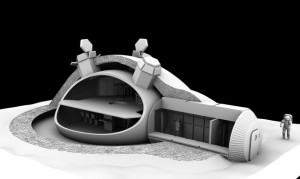NASA contractors have created 3D printed satellites – tiny wafers that could be deployed by the hundreds from a mother ship to cheaply transmit research data back to earth.
tiny wafers that could be deployed by the hundreds from a mother ship to cheaply transmit research data back to earth.
“One of biggest hurdles that NASA faces is understanding how to reliably build many satellites, many spacecraft … in a reliable and low weight way,” said Matthew Reyes, founder of Exploration Solutions, a sub-contractor for NASA’s Ames Research Center (ARC).
Reyes spoke at the Inside 3D Printing Conference and Expo here this week, emphasizing how the 3D printing process can ensure that parts are made to exact specifications by simply having a computer follow CAD-created designs.
Those CAD-created designs could be transmitted to outer space.
Along with Andrew Filo, an inventor, Reyes is also working with ARC’s SpaceShop, a machine shop designed to let astronauts complete do-it-yourself fixes using 3D printing techniques.
The goal of the effort is to commoditize parts for the aerospace industry, making them cheaper to create and send into orbit and beyond.
The point of 3D printing technology in space is to let astronauts be more self-sufficient by printing out whatever objects or parts they may need. Astronauts could use 3D printing to experiment by making their own unique objects, or producing replacement parts for things that break.
Reyes pointed out that if the 1970 Apollo 13 mission had included a 3D printer, the astronauts could have printed new parts to fix to broken spacecraft instead of jury-rigging it by cannibalizing other systems.
The Apollo 13 spacecraft was damaged when an oxygen tank exploded. It crippled the service module on which the command module relied.
Meanwhile, Made In Space has partnered with NASA’s Marshall Space Flight Center to launch the first 3D printer on a mission to the International Space Station (ISS). The company has built and tested a 3D printer that can work in zero gravity.
Once aboard the ISS, NASA or other the space agencies of other nations could transmit 3D CAD plans to the space station where the printed parts could be made. Then the astronauts would then assemble the parts for use on the station.
Reyes pointed out that parts in space are scarce due the high cost of the unique inventory, as well as the expense to rocket them into space.
Anything to reduce rocket payloads could potentially save millions of dollars, Reyes said.
“You can print a part for $4 or $5 using [polymers],” Reyes said. “What are we going to print on the International Space Station? We don’t know yet, but when we need it, we’ll be able to print it.”
Reyes said some of the “low hanging” fruit that 3D printing can address in terms of equipment in space includes spare parts, propulsion systems, plumbing pipes, even printed food, where a combination of organic ingredients can be extruded to make anything from a pizza to pasta.
Refrigeration and freezing require a lot of resources in space. Currently, food for astronauts consists of prepackaged shelf stable foods, processed with technologies that degrade the micronutrients in the foods.
According to NASA, the current food system “wouldn’t meet the nutritional needs and five-year shelf life required for a mission to Mars or other long duration missions.”
Printing satellites
The other hot area of research is 3D printed satellites, or mass production satellites.
Reyes and Filo have created a 3D printed satellite that can deploy hundreds of wafer satellites through a spring-loaded mechanism that spins them out into space on a flat plane so as to retain their orientation to collect sunlight for power, while transmitting to Earth.
Reyes said studies have proven that the mini-satellites have the potential to offer ubiquitous WiFi to everyone on Earth.
“Our goal is to make satellite construction as easy as downloading 3D CAD files to be printed, milled or otherwise assembled into functional spacecraft,” Reyes said.
The 3D printed rectangular “mother ship” that would be carried into space on a rocket is about 16-in height and with 4-in sides. It looks like a mini-skyscraper. Each level holds many small wafers about the size of a Wheat Thin cracker. The wafers are 3D printed plastic with tiny solar panels embedded for powering the electronic sensors and radio transmitter.
Up to 300 of the wafers could be deployed once the satellite was in orbit.
The tiny, 10 milliwatt satellites transmitters would use the Code Division Multiple Access (CDMA) encoding scheme, a cellular phone radio frequency, to communicate back with scientists on Earth. “That signal is actually many times stronger than the GPS signal you’d be receiving on your cell phone,” Reyes said.





